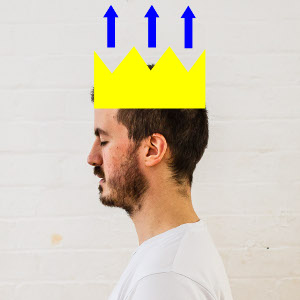Most people know what a good posture is, but do you get it? Because if you actively move yourself into a “good posture”, you will very likely add tension patterns to compensate the tension patterns that are creating your current posture. For this reason, the ideal tool to achieve good posture are images that will guide our nervous system towards the optimal organisation of our body, rather than aiming for the external appearance of good shape. Here are 8 of the best images I’ve worked worked with to achieve great posture.
Standing: press your feet into the floor.
That might sound a bit strange, but thinking of pressing your feet into the floor (the whole foot, including the heel and every toe) will ask your nervous system to organise in the most efficient way to receive the force from the floor (preventing you from falling through it), and this optimal setup of the body is a great posture.
Sitting: press your sit-bones into the floor or chair
Same principle than with the feet. To add to that image, you can then visualise the chair or the floor pushing back on you, and pushing your head up through your body.

See how I’m leaning forward? If I was thinking more about pressing into the chair, that wouldn’t happen.
Wearing a crown
Imagine that you wear a crown drawn by a child, with its series of points pointing directly up. Then let your head follow these points, and go up, up, up into the crown.
Float your head back and up
Imagine your head is a buoy on rails that run roughly parallel to the bottom of your jaw. Now float your head up and back, following the rails and rising water.
Take your neck back
While I’ve seen “take your head back” or “head back and up” many times in posture guides, I’ve never seen anything about the neck, which seems weird to me. Indeed, this is one the images that I’ve used with best results: think of taking your neck, and more precisely the section of your spine going through your neck, back. You can probably feel or visualise it as a curve going from the back of your chest to the back of your head, while curving forward. Now just think of the middle section, the curving-forward bit, coming back and straightening.
Play with muscle tone
This one is a bit more complex to describe. Remember you have muscles that pull bits of the spine together in pretty much every conceivable configuration. In particular, you have some that pull the back of your neck and the back of your thoracic spine together (flattening a hump), and some that pull the front of you neck and the front of your chest (in fact the top of your ribs-case) together (deepening a hump). Now imagine the front one elongating, and the back ones shortening.
Hold you lower back with your psoas
Your psoas is a pair of muscles attaching on the inside of your thigh and all along the lumbar spine, passing in front of the pelvis. For our purposes, we will focus on the lumbar spine bit: see these two muscles as gentle hands, carefully holding your lumbar spine from the front. Alternatively, see them as water-filled balloons, holding your spine by the force of the water pressure inside the balloons (like the towers of a bouncy castle that would be filled with water).
Unclench your bum
The muscles that press your buttocks together also push your pelvis forward. Relaxing them will help you take your pelvis back.
Look at people with great posture
Nothing helps posture like inspiration. Particularly helpful sources of inspiration for how a human should hold their body is people who live their life outside, interacting with nature every minute of the day (for instance, some indigenous Amazonian people), or people who are still close to these roots, or some of their portrayal in the media (like the women soldiers in Black Panther).

Continue reading: 5 Daily Opportunites to Perfect Your Posture, Foot Self-Massage, Walking Imagery – Back Line of the Leg.
This article also exists in French.
Want more like this?
Check out the following blogs from massage therapists I know from around London:- On The Run Health and Fitness on running, nutrition and sports massage.
- The Soma Room on sports massage and exercise.











No Responses